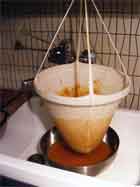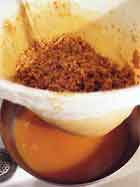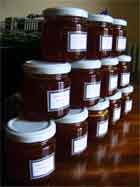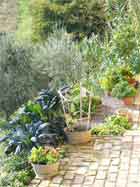CdP
13 October 2009

So now I can start doing those cold-weather things that seemed so far away. Like picking the medlars and trying to make medlar jelly which is really jelly rather than syrupy stuff I made last year, or like picking the many many green tomatoes that are still hanging on the plants, and making another batch of green tomato chutney. The first I made some weeks ago: there were simply too many tomatoes to consume in the normal ways, so I had to do something with them all. Anyway, having huge quantities of the stuff is no problem: my green tomato chutney is fast becoming legendary around CdP. Last week at a dinner party, the hosts told me “you’ve got to taste this amazing chutney. I don’t remember who gave it to us, but it’s absolutely fantastic.” Maybe I should sign the jars…
After the extreme heat of summer, the pleasant mid-twenties heat of après-summer was a second spring: the tomatoes, of course, had never flagged but they too on a new lease of life at that time; my experiments to get my useless courgettes producing failed miserably; but the unproductive bean plants which I had been considering pulling up as a complete waste of space were suddenly weighed down with more green beans even than they’d had in spring – lovely crunchy tender things and not even (yet) blighted by aphids. Will this cold stop them in their tracks? I hope not.
Talking of aphids, the little pests are, however, back on my artichokes. The ants herd them way down into the heart of the central-most, most tender shoots. I doused them all in pyrethrum yesterday, and will continue to do so at intervals, but it’s hard work trying to get rid of them. My poor artichokes always die back completely in high summer. Why is this? I see great, glorious plants growing wild in fields, untended and unwatered, all through the dry summer while mine are wilting and dying miserably. But they spring back, better than ever, soon after wilting. All I need now is to hive off some of the new growth and plant the tiny things in the new bit of garden I’ve created there, on the right hand side of the drive as you go up the hill. I’m going to put them between Rosa chinensis mutabilis and black hollyhocks and lavender. I wonder slightly how I’m going to get in there, among the rose bracts, to weed such a wide bed but I’ll cross that bridge when I come to it. Even more crucial, at the outset, will be trying to transform the stony sandy soil there – mostly tufa brought in to pad around the buried LPG gas tank, mixed with stones brought up from way down the bottom of the gas tank hole – into something fertile enough for my chosen plants to grow in. I’m going to have to shift large quantities of compost and manure and anything else half-decent I can get my hands on. Time and humus – plus regular additions of manure – will, I hope, do the rest.
Emerging from that same bed are the little fruit trees I put there last spring – the cherry and two plums. I have created another space for a fourth tree: a Sapindus detergens or S. mukorossi – a soapnut tree – if I can find one. From the photos I’ve seen, they look like pretty plants, and their natural high-Indian habitat isn’t all that far from ours, with hot dry summers, and freezing cold winters. The soap nuts I’ve been using to wash our clothes all summer really do seem to work. So why not produce my own? I must, however, find out whether one will do or whether I need two to produce fruit. Also there – and I have these, ready to be planted, but do I ever get around to it? – will be a hedge of Acca sellowiana (feijoa) following the slope up to the orchard level. They don’t like wind, but finding a wind-less corner in our place is just too difficult. I’ll keep them low and thick and hopefully they’ll end up producing some of their wonderful fruit. If not, they’ll just look elegant with their grey-green leaves.
Hunting season has started again now, and strange men with guns and over-excited dogs appear regularly in the lanes and fields. In Capalbio, where I’m working on a vast garden/play farm with Peter C, they looked into the regulations for creating a fondo chiuso – a property where hunters can’t amble across and blast away with impunity. The first and most important requirement is an impenetrable wire fence, at least 1.5 metres high. Around the whole property. The result may stop hunters, but it’s unspeakably ugly: there are a couple up on the CdP-Perugia road which look like military installations poking out of otherwise glorious rolling high-plateau countryside. And of course, unless you happen to trap a beast or two in there when you’re putting the fence up, there are no animals being protected in there anyway, because anything un-winged simply can’t get in. Every now and then, I‘m ashamed to have to admit, as I survey my burgeoning cabbages with pride and remember the carnage wrought on my crop last year, the sound of a gunshot ringing off away in the valley doesn’t exactly fill me all the anti-hunting fury it should. I think I’ll salve my conscience by rigging up some kind of munching-beast protection for those beds, and I’ll have to do it soon. As soon as the cold descends, they seem to find my orto appetizing.
Nuts have been playing a large part in our lives over the past few weeks. There wasn’t a single useful hazelnut on those big old trees in the field, or at least, there wasn’t by the time I got down there, which was, I admit, a bit late. But what walnuts we have this year! They’re about twice the size of the wizened specimens of 2008. This year I took the trouble to scrub each one down, and the basket full of them sitting by the fireplace looks so appealing. They won’t last long. Last year I simply couldn’t be bothered to take all the ugly black filaments off. I read that not cleaning them properly adversely affected the taste. But as it was a bad year last year, who’s to know whether their quality was due to that, or to my laziness?



